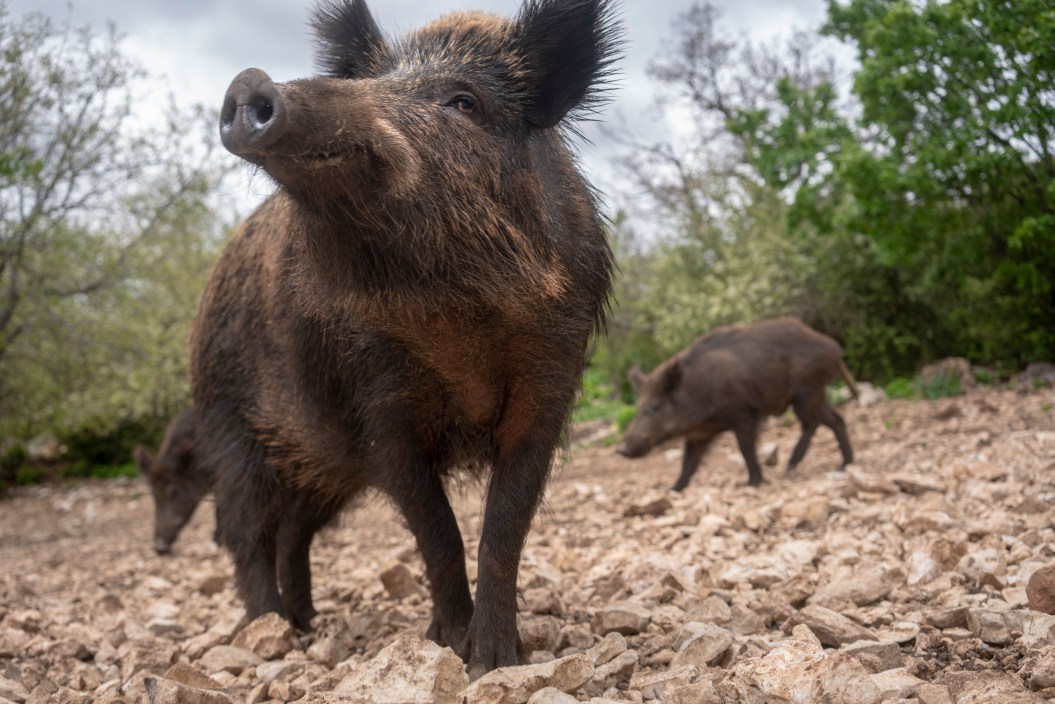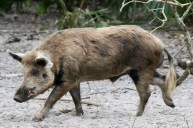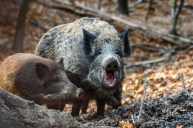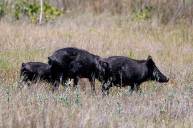Wild hogs are wreaking havoc across the country. Wild boar are incredibly distructive digging up holes six-inches deep, tearing out entire hillsides, and eating pretty much anything they can forage, including roots, crops, snakes, birds, even deer fawn. No green space is safe, as the destructive pigs tear up lawns and golf courses in neighborhoods and terrorize farmers as they dig up crops and destroy their fields.
While feral swine have been in the United States for several centuries, the population has exploded over the last 30 years. And considering there are currently around six million feral swine across at least 31 states, according to the United States Department of Agriculture—that's a lot of damage.
Most states dealing with these invasive swine encourage eradication by almost any means necessary, like Texas. But despite having just as big of a problem with the wild hogs, Missouri, uniquely, does not.
Missouri's Feral Hog Problem
Free roaming pigs have established populations in at least 35 Missouri counties, according to the Missouri Department of Conservation (MDC). Most of those are concentrated in the southeast corner of the state, with Iron County considered ground zero. Nearby Madison, Wayne, and Reynolds counties also have large feral pig populations.
The MDC believes much of the problem stems from high-fence operations that offered European wild boar hunting opportunities in the 1990s. Those boars escaped and a wild population rooted in Missouri.
The MDC believes that in addition to those ancestral escapees, illegally released swine are contributing to the population boom. It is suspected that pigs are being released on both public and private land with the intention to establish a huntable population. In press release, MDC Wildlife Management Coordinator Alan Leary said it's a problem that's spreading across the state.
"We've also trapped hogs in other parts of the state, which unfortunately means people are still intentionally releasing feral hogs for hunting," Leary said. "It's vital we continue our efforts and get the population under control before it spreads any further."
Why Missouri Doesn't Want You Shooting Feral Hogs
Feral hogs destroy native wildlife and human agriculture. A large sounder (group of pigs) can wipe out an entire crop in a single evening in some cases. It's estimated hogs account for $1.5 to $2.5 billion a year in damages. Plus, they can potentially spread diseases like brucellosis and leptospirosis to humans.
In many states with hog problems, such as Texas, anything goes. The state wants the swine eliminated by any legal hunting or trapping means.
In Missouri, the MDC is taking a different approach: It's mostly outlawed the hunting of feral swine on public lands.
Wildlife biologists in Missouri believe hunting of the animals can do more harm than good. For starters, wild hogs have an high reproduction rate, so shooting just one or two hogs doesn't do very much to reduce the population.
But moreover, when hunters shoot feral hogs, it complicates efforts to remove these pests, the MDC says. That's mostly because shooting one or two hogs scatters the sounder. In turn, the hogs become trap-shy and more wary of the state's baited sites, which makes efforts to catch the entire group at once more difficult.
The MDC prefers to catch the entire sounder in large pen traps where they can capture the most hogs possible.
The Missouri Feral Hog Elimination Partnership
The population reduction efforts in the state are headed by the Missouri Feral Hog Elimination Partnership.
The partnership is comprised of 13 federal and state agencies along with numerous agriculture and conservations organizations.
Partnership employees were able to assist 1,308 landowners and scout more than 3 million acres for feral hog damage in 2021. The top counties where feral hogs were removed include Iron County with 1,940 hogs, Wayne County with 1,329 hogs, and Reynolds with 1,268 hogs.
Efforts made by the Partnership have resulted in a 48.5 percent decrease in the number of watersheds occupied by feral hogs in Missouri since 2016.
So, Can You Hunt Feral Hogs in Missouri?
The answer to this question is technically yes, under strict regulations.
In 2016, the state closed most public lands to all hog hunting and trapping except for what was being done by the partnership's trapper employees. This includes popular public areas like the Mark Twain National Forest, which is a popular place for both deer and wild turkey.
Private landowners and their guests can harvest feral hogs on their own land. Missouri does not have a listed season anywhere in their regulations for feral hogs. That's because the state does not consider hogs game animals, but rather an invasive species.
In 2020, the MDC allowed the use of night vision, thermal, or infrared as aids in the taking of hogs, just like many other states had already done.
Things got a little bit confusing when the MDC amended the rules again to allow "opportunistic" harvest of feral hogs on public lands. From the MDC's own book of regulations:
"During deer and turkey seasons, opportunistic take of feral hogs by hunters with an unfilled deer or turkey hunting permit is allowed on lands owned, leased, or managed by the Conservation Department."
In other words, hunters are allowed to harvest incidental hogs that they may encounter while hunting deer or turkey. For example, if a hunter is sitting in a blind and a sounder wanders past, they could harvest a hog, but they cannot be there specifically targeting hogs.
Proposed regulation changes are currently under consideration.
Next: Where Did Feral Hogs Come From Anyway? A History of Feral Swine in America
WATCH



